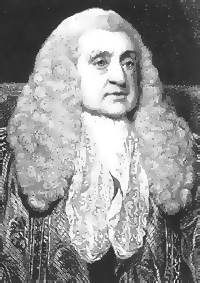 |
 |
|||
|
|
 William
Scott, Lord Stowell (1745-1836) William
Scott, Lord Stowell (1745-1836)Born: 17th October 1745 at Heworth, County Durham Lord Stowell of Stowell Park Died: 28th January 1836 at Earley, Berkshire William Scott was the eldest son of William Scott Senior, who was in business as a coal merchant in Newcastle-on-Tyne, and of Jane Atkinson. He became a famous lawyer, as stout a Tory, as great a drinker of port wine and a great scholar. He received his education at Newcastle Grammar School from a Fellow of Peterhouse, Moises. William obtained a scholarship at Corpus Christi, Oxford, and later became a fellow of University College which his brother, John (later Lord Eldon), had attended. He embraced the profession of the Law and was well qualified, by scholarship and reading, to mix in the best literary society of London. He was the intimate friend of Dr. Johnson, in his old age, and a member of 'The Club'. William Scott inherited, in 1776, considerable property from his father and was called to the Bar in 1780. His first office was that of Advocate-General to the Admiralty (1782) and, along with Ecclesiastical Courts, this always remained his sphere as a “lawgiver rather than a judge”. In 1788, he became, successively, Judge of the Consistory Court of London, King's Advocate-General and Vicar-General for the Province of Canterbury. Ten years later, he became Judge of the Admiralty Court. These offices did not exclude their holder from a seat in the House of Commons and Scott sat from 1790 until he obtained his peerage, the Barony of Stowell, in 1821. From 1801, he represented the University of Oxford. He took no active part in politics and concerned himself wholly with such legal questions as arose in the House, but his votes were steadily given upon the Tory side. He resigned his judicial office in 1828 and retired to his wife's ancestral home of Erleigh Court in Berkshire, where his mind gave way soon afterward. He lived to be ninety and was buried in his local parish church of Sonning. He is commemorated by the 'Stowell Fellowship' at his old university. Lord Stowell had married Anna Maria, eldest daughter and heiress of John Bagnall of Erleigh Court, near Reading, on 7th April 1781. Their son, William, "a heavy indolent man," died at Erleigh Court only two months before his father. The Barony thus became extinct and the family estates passed to his Lordship's daughter, Mary Anne, the wife of Viscount Sidmouth. Edited from Emery Walker's "Historical Portraits" (1909). |
|||
| © Nash Ford Publishing 2001. All Rights Reserved. | ||||




